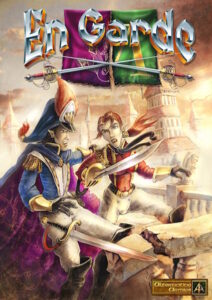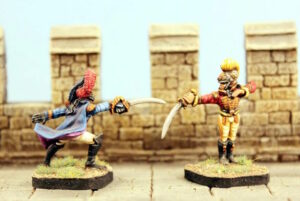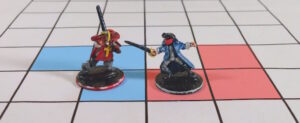 My recent travels have led me to conclude that my collection lacks a suitable shelf of one-on-one combat games. If you think about it, these are a natural for the more mobile gamer who has to consider variables such as weight and portability. If all you need is a couple of figures, a sack of dice, and maybe a drop cloth, you’ve got everything you need for hours of gaming.
My recent travels have led me to conclude that my collection lacks a suitable shelf of one-on-one combat games. If you think about it, these are a natural for the more mobile gamer who has to consider variables such as weight and portability. If all you need is a couple of figures, a sack of dice, and maybe a drop cloth, you’ve got everything you need for hours of gaming.
BUT!
To get hours of gaming out of a game, you need a game worth hours of play, and the few one-on-one games that I’ve played have left me cold. They are either too simple and quickly devolve into two static figures bashing each other – the dreaded ‘roll to hit, roll for damage’ cycle of most Moldvay D&D combats – or they are too complex and you spend more time fiddling with the rules than the strategy. In many cases, the one-on-one games are just skirmish games stripped down to two combatants, and you lose the movement and hunt for ideal matchups that make skirmish games worth playing.
Or a game might expect players to track all of the little statuses our figures have, and the list is a long one. You need to worry about strength, reflexes, endurance, mobility, attack ranges, the ability to avoid damage, the ability to fight despite damage, the effects of armor, and so on. Juggling too many numbers turns a game of flashing swords and mental trickery into pure dredgework.
 Enter Alternative Armies’ En Garde.
Enter Alternative Armies’ En Garde.
Set in the years before the events of Flintloque, En Garde, takes a deep look at the (mostly) honorable duels between elvish nobles. I say mostly because there was an elvish civil war going on at the time. The fancy elvish chrome can easily stripped off and a thick layer of Hollywood mud applied to open up the game to a more historically minded audience. Although I love the duelling elves available at Alterntive Armies and think they would make for fine additions to any collection – and even inspire some interesting elvish factions in a D&D campaign – I am alas committed to 15mm. So my duellists come from Old Glory slash (heh) Blue Moon’s Three Musketeers line.
It’s a little hard to know where to begin to explain how the game works, and the rulebook itself doesn’t do any favors in that regard, because there are several small sub-systems that link up to create a game that is greater than the sum of its parts. And somehow this allows the authors Steve Danes and Gavin Syme give the players just enough to do without overwhelming them.
There is a lot more to the game than a simple clash of blades. A lot more:
- Weapon breakage
- Disarming rules
- Pistol duels
- Horseback duels
- Brawls with multiple opponents on a side
- Terrain effects including a fight on the roof of a burning building
- An honor/experience system
- Fighting schools that grant additional power-ups and limitations
For today though, let’s just look at the core mechanics of a standard fight.
The most important concept is the dice pool. The game uses d6s, d8s, d10s, d12s, and d20s to conduct its business. These are used for the round’s actions, with a 5+ necessary to succeed. A duelist will generally have nine dice in his pool, though touch ones will have one or two more and weak ones one or two less, and as the fight progresses the players will lose dice until they have just one left. At that point the figure is exhausted and collapses in defeat.
At the start of each round each player secretly takes one die from their pool. Bigger dice are more likely to succeed, but the smaller dice activate first. In addition to that, the die type selected determines the movement allowed by the figure during this round as follows:
- d6 = withdraw
- d8 = sidestep
- d10 = advance a square or two
- d12 = pivot in place
- d20 = charge ahead three spaces
Players reveal their chosen die at the same time. If both players show the same die they roll off with the higher score choosing whether to move first or second. As one would expect, faster reflexes give a figure a bonus to this roll-off. This leads to an interesting game of cat and mouse as figures jockey for position, seeking to get to a square and facing where they can strike their opponent without fear of being attacked themselves.
To really understand how footwork impacts the game, we pause to discuss weapons. In addition to the modifiers for speed or damage, each weapon has a striking template. Here is a shot of two figures who have locked blades and are trading blows:
 The guy in the blue overcoat on the right threatens the three blue squares with his rapier. The Cardinal’s guard wields a longsword that threatens the three red squares. If the Cardinal’s guard stood one square to the left as we see the fight, he would be able to attack his foe without fear of a retaliatory strike. Alternatively, if the masked man stood just one square closer to the camera, he would be able to launch an attack without fear of retribution. If both figures wind up in the same square, then a shoving match results which amounts to a roll-off using your action dice. The winner pushes the loser back one or more squares, depending on how over-powering he was. Alternatively, a figure armed with a knife can attack a figure in the same square using the process outlined two paragraphs below, which over-rules the shoving match.
The guy in the blue overcoat on the right threatens the three blue squares with his rapier. The Cardinal’s guard wields a longsword that threatens the three red squares. If the Cardinal’s guard stood one square to the left as we see the fight, he would be able to attack his foe without fear of a retaliatory strike. Alternatively, if the masked man stood just one square closer to the camera, he would be able to launch an attack without fear of retribution. If both figures wind up in the same square, then a shoving match results which amounts to a roll-off using your action dice. The winner pushes the loser back one or more squares, depending on how over-powering he was. Alternatively, a figure armed with a knife can attack a figure in the same square using the process outlined two paragraphs below, which over-rules the shoving match.
So what’s to stop a game from turning into a long dance with no real combat? Movement. An unarmored figure can only move six squares before he is obliged to halt for a round and only activate on a d6 as he gasps for breath. Armor will reduce that number and more robust fighters might have a bonus of up to three additional squares. This gives duelists with more ‘wind’ a chance to position themselves for that safe kill shot, and forces those with less hearty constitutions to balance the need to close with the need to preserve their strength.
And now at long last we get to the attacks. Here we have another little mini-game and bluff-counterbluff bit of fun. There are six basic attack maneuvers possible, though duelists may not know all six of them and some weapons may not be capable of performing all of them. Rapiers cannot slash, for example. The defender chooses on of the six attacks to defend against and writes it down or signals it with a hidden d6. The attacker announces his intentions and if the two match, the defender has successfully blocked the attack, no dice needed. If the attack is not defended against, then you break out the dice and roll the activation die from earlier, hitting on a 5+. You roll that same die again, add a modifier for the weapon strength, and for every five full points that result you deal out one wound to your foe.
If your attack misses, that die is removed from your dice pool and you have one less option for the next round. This leads to a two-tiered system of endurance. On the one hand, you have the movement system that forces figures to take a round off. On the other hand, if you can weather enough attacks from your opponent, you can win without ever landing a blow just by waiting out his misses.
The end result is a duel with two phases of bluffing and guesswork each round, and one where players can easily track a host of status conditions with a minimum of bookkeeping. The word ‘elegant’ gets thrown around a lot these days, and in this case with good reason. Best of all, the game really does a wonderful job evoking – in the players themselves – the same sort of feint-and-thrust and parry-and-bluff engagement as the duelists themselves.
And all in one small and easily portable game system.


This is one of the best reviews I’ve ever read about a game which seems more than interesting!! Thank you very much.
Sounds like good fun! Nice write up Mr!